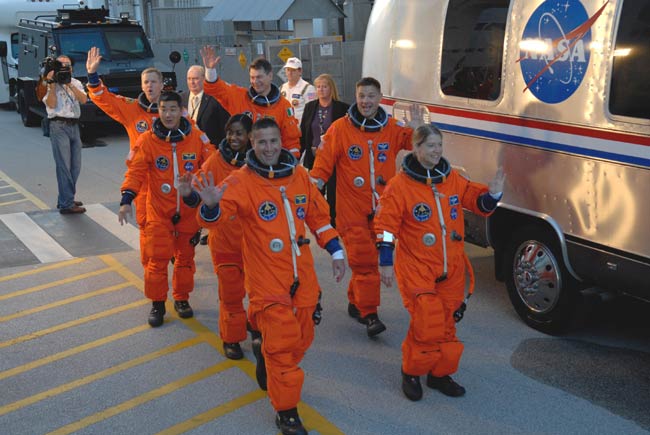NASA Aims for Oct. 23 Shuttle Launch

CAPE CANAVERAL – In an engineering showdown next week, shuttle managerswill recommend launching Discovery on Oct. 23 despite concerns raised by anindependent safety group about tiny cracks in critical wing panels.
NASA shuttle chief Wayne Hale will tell agency leaders thatthe defects are too small to allow hot gases to burn through the compositecarbon covers and destroy the spaceship during atmospheric re-entry.
And he'll note that new testing techniques developed afterthe 2003 Columbia accident show the cracks have not grown despite repeatedexposure to re-entry temperatures as high as 3,000 degrees Fahrenheit.
"As it stands right now, based on the discussions andthe detail that Wayne Hale heard yesterday, he said the risk as laid out isacceptable to proceed with the launch," Kyle Herring, a spokesman forNASA's Johnson Space Center, said Thursday.
Get the Space.com Newsletter
Breaking space news, the latest updates on rocket launches, skywatching events and more!
However, experts from the NASA Engineering and Safety Center, an independent advisory organization established after the Columbia accident, onWednesday recommended that NASA replace the panels as a precaution.
"They felt that the prudent thing to do would be tostand down and just swap out the panels to be sure," Herring said.
Doing so would force NASA to roll the shuttle back to itsassembly building, disconnect Discovery from an external tank with attachedsolid rocket boosters, and return the orbiter to its processing hangar.
Launch of the U.S. Harmony module and the time-criticalconstruction of the International Space Station would be delayed at least twomonths.
NASA would be hard-pressed to launch 13 outpost assemblyflights and a Hubble Space Telescope servicing mission before September 2010, apresidential deadline for station completion and shuttle fleet retirement.
NASA Administrator Mike Griffin and top agency executiveswill make a call during a Flight Readiness Review on Tuesday at Kennedy Space Center.
Shuttle orbiter wings each are outfitted with 22 compositecarbon panels that protect them from extreme temperatures during atmosphericre-entry.
The U-shaped panels are coated with silicon carbide toprevent oxidation, which reduces their structural integrity.
The manufacturing process exposes the panels to temperaturesup to 3,000 degrees, and as the silicon carbide cools, small defects called"craze cracks" form.
The cracks – similar to scratches in the clear coat of anautomobile finish – are filled with sealant.
Inspections after NASA's first post-Columbia test flight inJuly 2005 – a mission flown on Discovery – showed that the sealed cracks insome cases could open and expand during flight.
A new technique that employs a heat source to detect smalldefects was used to perform the tests.
Underlying composite carbon on one of Discovery's wingpanels sustained enough damage to prompt NASA to replace it.
Two other tiny cracks on the orbiter's right wing and one onits left were discovered.
The panels nonetheless were deemed safe to fly and NASAformed an internal team to try to pinpoint the cause of the problem.
In the meantime, engineers continued post-landinginspections to see whether the small cracks expanded during flight.
Discovery flew twice in 2006 and the cracks have notchanged.
Still stumped on the root cause, shuttle managers asked theNASA Engineering and Safety Center to study the matter.
The request came prior to a shuttle mission in June.
Discovery rolled out to launch pad 39A on Sept. 30.
The independent experts circulated a draft report Oct. 5.
A formal presentation was made during a shuttle programreview Wednesday.
The root cause still is unknown, so the group contends NASAcannot adequately estimate the risk posed by the small cracks.
They said the prudent course is to replace the three panels.
The experts on the internal shuttle team recommended flying"as-is."
NASA leaders are pondering three options.
- Launching Discovery as scheduled in 11 days.
- Rolling the shuttle back to its hangar to replace the suspect panels.
- Ordering more testing and analyses in a bid to prove Discovery is safe to fly "as-is."
More tests and analyses, however, could be inconclusive.
Hale will recommend flying "as-is" and continuingtests.
"That's basically Option One," Herring said."You fly and continue to try to understand what causes this phenomenon."
Publishedunder license from FLORIDA TODAY. Copyright: 2007 FLORIDA TODAY. No portion ofthis material may be reproduced in any way without the written consent of FLORIDA TODAY.
Join our Space Forums to keep talking space on the latest missions, night sky and more! And if you have a news tip, correction or comment, let us know at: community@space.com.
Todd Halvoron is a veteran aerospace journalist based in Titusville, Florida who covered NASA and the U.S. space program for 27 years with Florida Today. His coverage for Florida Today also appeared in USA Today, Space.com and 80 other newspapers across the United States. Todd earned a bachelor's degree in English literature, journalism and fiction from the University of Cincinnati and also served as Florida Today's Kennedy Space Center Bureau Chief during his tenure at Florida Today. Halvorson has been an independent aerospace journalist since 2013.
